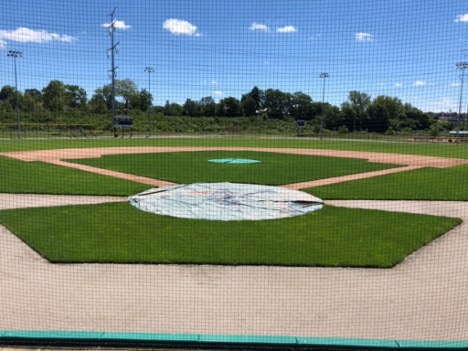Infield lips threaten safety, playability, and maintenance on baseball and softball fields. This blog post will explain what infield lips are, how they form, and how to prevent them. We’ll also discuss how to repair a lip if it’s too late for prevention on your field.
When infield material builds up at the edge of the turfgrass, the raised edge is called a lip. Infield lips form due to erosion and traffic if maintenance practices are not in place to counteract these factors. Lips can form anywhere the field transitions from a skinned surface to turfgrass, including along the warning track.
Infield lips aren’t always visible, but that doesn’t mean they’re not a problem. In fact, players may be more likely to stumble on a lip because they can’t see it. In addition to the tripping hazard, infield lips can cause bad hops that influence the game itself.
From a maintenance perspective, infield lips also influence drainage and playability after rain. Although the elevation of a lip may not seem like much, it can be enough for water to pool at the edge of the turfgrass. The unevenness ultimately requires additional maintenance to manage water on the field.
Proper infield maintenance practices can prevent lips from forming. When dragging an infield topped with conditioners, drag it to the edge rather than into the grass. Rake edges tightly or groom them by hand, not with machines. After each game, use brooms, blowers, rakes, or vacuums to remove clay chunks and conditioners that get tracked into the grass on cleats. Detail work is crucial to maintaining smooth transitions.
When you have a multi-day break from play between tournaments, it’s a good idea to move conditioners in from the edges of the infield. This practice limits the materials that can migrate into the grass with rain or wind. For the same reason, you should completely strip the infield of conditioner during the off-season.
Daily maintenance can’t always remove all of the material from the turf, so take advantage of longer breaks to be more thorough. Compressed air or high-pressure water hoses are effective in blowing out conditioners that have settled into the grass. However, these practices are hard on the grass and can do damage if not managed carefully. Be careful when completing a maintenance project like this.
Early- and late-season rolling of the edges can also help tighten the transition from dirt to turf. Just make sure to find your field’s sweet spot with moisture. If it’s too wet, rolling can damage the dirt and grass. If it’s too dry, the dirt won’t compress under the roller. Drought and heat can also make rolling more damaging to grass, so be intentional about timing.
Finally, be realistic and acknowledge when lips become so bad that they must be replaced. Safety is paramount, so make it your gauge for when a renovation is necessary. You can use a sod cutter to remove the edge of the turf and then remove the infield material with a rake before resodding the edge.
Once you’ve achieved a smooth edge, keep up with maintenance to prevent another infield lip. Your ATS rep can help determine if a renovation is necessary or if you can correct a lip with a strong maintenance plan.













